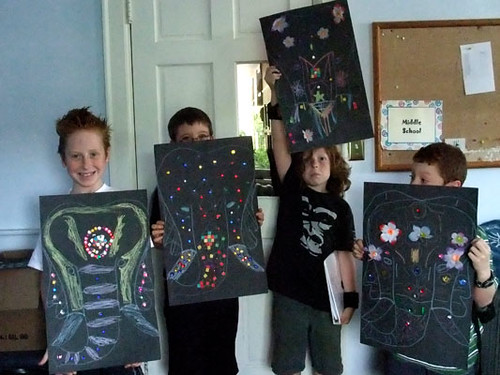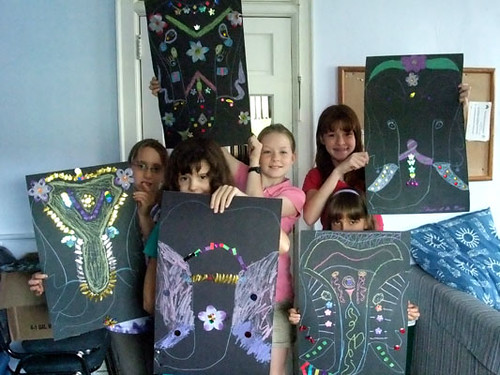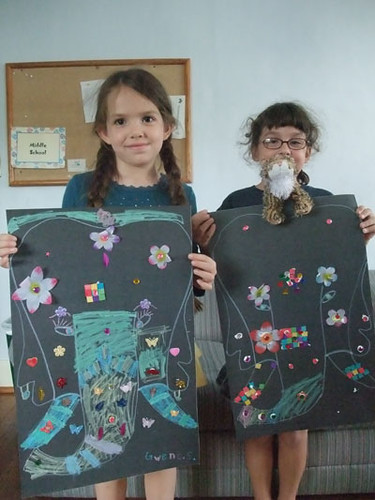
Namaste.
Decorated Elephants Art Project. Because our project was so involved and I wanted the children to have the maximum amount of time possible to work on it, we started right away.
Each student started with a blank elephant outlined on a half sheet of black posterboard in gel marker:

Materials:
Blank elephants on black posterboard
Gel markers
Chalk
Colored rhinestones
Fabric flowers
Shimmery shapes
Wooden tiles
Cardboard tiles
Sequins of all shapes and sizes
Bottles of Tacky glue
The only instructions: Outline with markers. Color with chalk. Use glue in dots only. No big piles of glue, no glue lines, no puddles, no glops. Dots only. Demonstrate. Dots of glue is the secret of success with this project!
Here are some examples of our finished work:



Here is a link to tons more images of my adorable students and their work.
Songs. While we did our projects, we sang our songs, and many of the students have memorized the first verse of If and the first verse of Mandalay. This is exciting! We moved on to working on the second verses.
Quiz. Here it is -- see how you do! Which of these statements are true?
1. The white man in charge of the elephant capture operation is called a mahout.
2. An elephant works with many mahouts in the course of his life, because it’s dangerous for an animal to become attached to one person.
3. A mahout can communicate orders to an elephant with a word or a touch.
4. The difficult terrain in Northeast India makes it necessary to use elephants for work.
5. Elephants cannot be used to carry guns because they have a strong pacifist ethic and will not move forward carrying weapons.
6. If you were a king or a celebrity in India, you would probably ride an elephant in a parade.
7. Elephants in parades are decorated with black shawls, black yarn wigs, and coal dust, to remind everyone of night.
8. During a khedda capture, elephants are driven into large pools of warm milk, which makes them sleepy and easy to work with.
9. Tame elephants are used to calm down wild elephants that are being captured to tame.
10. Ganesha is a Hindu god with an elephant head.
If you want the answers, ask your child.
Toomai of the Elephants: We had three teaching points today.
1. Point of view. The story "Rikki Tikki Tavi" was in the point of view of the animals, and we could hear the animals talking and see the world from their perspective. "Toomai of the Elephants" is in the point of view of the humans, and we see the elephants from the outside. I asked the students why they thought this might be, and they came up with some interesting thoughts. For example, Sarah pointed out that if we heard from the elephants POV, we would know that the dance was real from the beginning. I asked them why they thought Kala Nag came back to the camp, after the dance was over. To me, this is one of the big mysteries of the story, and one of the most important elements. If we heard from Kala Nag, if we could hear him talk, we would know the answer definitively, but without that perspective, we have to guess. Several of the children thought Kala Nag might be coming back to return Little Toomai -- I thought that was interesting. Others suggested that he was afraid to be free in the forest after being a tame elephant all his life.
2. I asked the students if they could think of ways that Toomai and Kala Nag were similar. The answer I was looking for was the fact that they both drummed to express themselves and communicate with the world -- Toomai on his tom-tom and Kala Nag in the elephant dance. They did give me that answer, but Abigail also pointed out that Toomai and Kala Nag were both kind of caught in their circumstances, servants and enslaved -- the elephant in his ropes and pickets and Toomai by his station in life. I thought this was very insightful and it was exactly what I was getting to with my line of questioning.
3. I told the children that there were was a line in the story that bothered me: "Native children have no nerves to speak of." We discussed what that line might mean, and I told them I found it wrong and sad: All children have nerves. We talked about the fact that in colonizing another country, the dominant culture has to define the dominated culture as less important, less valuable than themselves, to allow themselves to use them and oppress them. We looked at this line as an example of the British "Sahib" making it possible to treat these children poorly. We can absolutely see this as wrong, but we have to ask where this sentiment is coming from. Is it the character's sentiment or is it the author's sentiment? I told them that I wasn't sure whether this was Kipling's idea or Sahib Petersen's idea, and that this was a question we would look into further as we went deeper into the book.
Assignment: The fast facts for this week cover the Hindu pantheon. The reading assignment for next week is "The White Seal."
Links:
A fur seal rookery.
A northern fur seal, showing its sharp teeth.
In case anyone is interested in some serious information about fur seals, here is some.
Fur seals on Enchanted Learning.
More fur seals with a big bull in the front and center.
Video of a female seal finding her pup in a group, just like Kotick and his mom.
Baby fur seal and his mom.
The White Seal animated movie (by Chuck Jones) Part I
The White Seal animated movie Part II
The White Seal animated movie Part III
Warning: Do NOT let your child search around on YouTube or Google for fur seal links without you. There are extremely disturbing images and videos of seal culls, and the fur trade. Not appropriate for children AT ALL. Like, nightmares for life type stuff.

We love the pictures! How cool is that!?!?! Thanks so much!
ReplyDelete